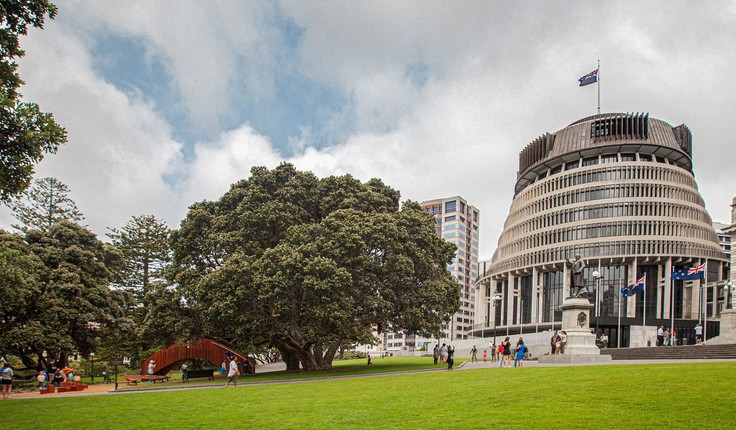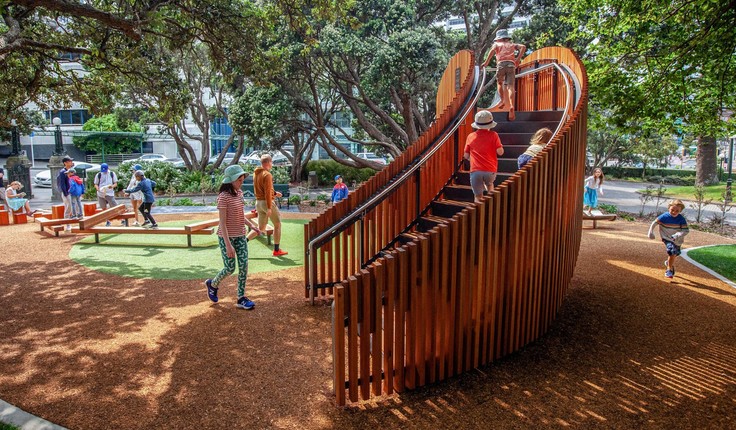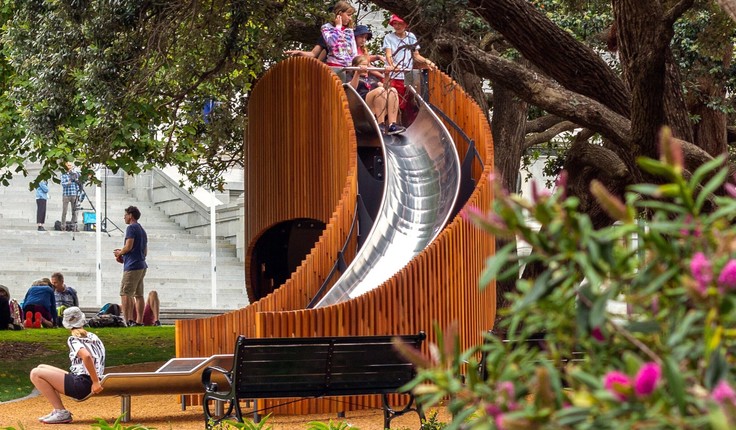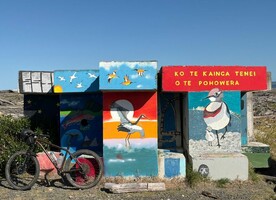News
Parliament's play space
Posted 12 05 2020
in News

By Studio Pacific Architecture
“Children learn through play, but adults play through art…we don’t stop playing.”
– Brian Eno
The Parliamentary Play Space is a government-initiated project aimed at increasing the accessibility and interest of Parliament to children and young families, making it more friendly, open, and welcoming. It also aims to fill a void of play spaces within one of Wellington’s most densely populated urban areas – opening up the central business district to children.
Throughout history, New Zealand’s Parliament has had an important role in pioneering social change. It has been a champion of issues such as women’s suffrage, nuclear-free New Zealand, Treaty of Waitangi settlements, and more recently marriage equality and the NZ Zero Carbon Bill. A public play space within the grounds of Parliament shows a strong commitment to the rights of children and continues Parliament’s history of pushing for societal change.
The brief for the play space was to create a ‘neighbourhood play space’, a handy place for a quick play that reflects the site’s context, expresses cultural and environmental values, and is aesthetically complementary to the existing grounds and historic buildings.
Set amongst a group of mature trees on the front lawn of Parliament, the English garden style of gently-rolling lawns and groves of trees provides an attractive setting. The site is a well-kept open space for daily informal public use, public gatherings, celebrations, memorials and protests; and as part of the Parliamentary Precinct Conservation Area it has a recognised special character. Whilst introducing a play space, we sought to maintain and enhance the quality and character of the existing landscape, being mindful of its historic setting and prominence.
In Brian Eno’s 2015 John Peel Lecture ‘The Ecology of Culture’ he recognises both the importance of play for children in enabling empathy and social learning but also the importance of art for everyone. Therefore, our concept for the play space was to create a sculptural and playable landscape to stimulate the imagination of its visitors and encourage children (and adults) to engage with and explore nature.
Let’s pretend that slide is the mouth of a dragon
Let’s pretend that there’s a taniwha chasing us
Let’s pretend that there’s treasure buried somewhere here
Let’s pretend we’re Kaka flying through the trees
A discovery trail threaded into the landscape incorporates sinuous paths, woven through the trees – with sculptural forms projecting out from the ground and diving back under, a clue to what could lie beneath. Something to run along, jump off, weave in and out of. A path to navigate and explore, both on the ground and up amongst the trees – with steps leading up to a slide hidden in a nest of sticks.


Design features of the play space include:
The sinuous slide referencing the shape and movement of the New Zealand longfin eel and reflects the nearby hidden Waipiro stream
Subtle Māori taniko patterns are woven into the detailing of the native red beech (Nothofagus fusca) timber cladding - sustainably sourced from areas of wind-blown forest
Play elements such as timber steppers and balance beams
A central ‘lawn’ gathering space suitably sized for school groups to gather and learn
Heritage and archaeological assessments were also undertaken to identify any associated issues. For example, employing a natural material palette to blend in with the existing landscape.
Carefully siting the play space within the grounds in order to respect its historic context was a crucial part of the design process.
Navigating between three mature pohutukawa and lime trees added further challenges and opportunities to both design and construction. Consideration was given to the arrangement of elements within the space to highlight and mimic the natural curves of the trees whilst also limiting the extent of earthworks to protect the trees’ roots.
As part of this, arboricultural work was undertaken on the trees to ensure their longevity and mitigate any associated public health risks. Heritage and archaeological assessments were also undertaken to identify any associated issues. For example, employing a natural material palette to blend in with the existing landscape.
New Zealand’s Prime Minister Jacinda Ardern formally opened the project to the public on World Children’s Day, 20th November 2019 - marking the 30th anniversary of the UN Convention of the Rights of the Child.
“The agreement said that children have the right to grow up in a place that looks after their well-being, where they are loved and they are nurtured… what better message can we send, that we’re focused on the well-being of kids than giving them a space to play in the very place where we are given the job of looking after them”
Rt Hon. Jacinda Ardern.
Share
19 Dec
Christmas break 2025

see you from 12 January
As we wrap up another big year, we’re taking a moment to pause, breathe, and enjoy a well-earned break. Meri …
18 Dec
President’s update

December 2025
Earlier this month I attended the Ngā Aho Māori Design Professionals Wānanga-ā-Tau at Te Aranga Marae in Flaxmere. Tuia Pito …
18 Dec
Awards 2026 update

An update as we warm up for the 2026 Awards kaupapa. Submissions will open in March and will run for …
Events calendar
Full 2025 calendar